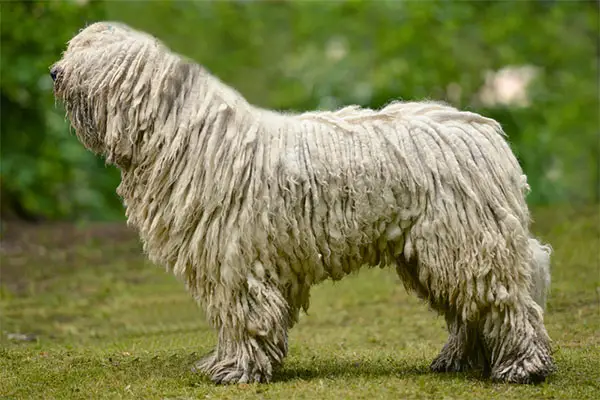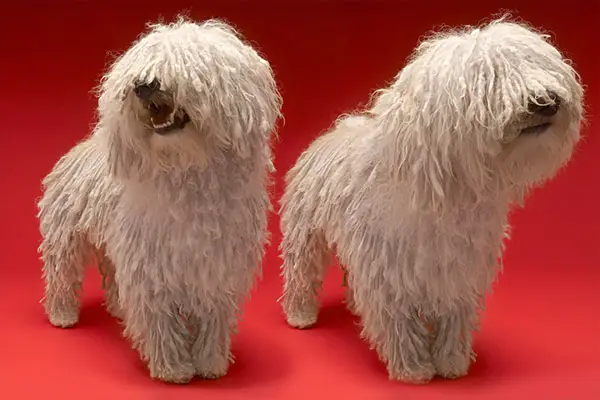The Komondor is a large to giant-sized dog from Hungary. They usually stand at a height of 27.5 inches with their large bodies covered with white, corded cords. They are unique-looking dogs who can certainly make anybody’s head turn.
From their coats itself, you can already tell that these dogs are not for beginners. But other than that, they come with more responsibilities, such as giving them enough exercise and attention. It’s also essential to show confident leadership when around these smart dogs.
However, even if they can be too much to handle, they can be the best family dog companion you can have for the right owner. They enjoy most of their time when spent with you, and they’ll surely be your great friend and guardian.

Komondor Statistics
| Dog Breed Group | Working |
| Breed Size | Large to Giant |
| Height | 27.5 minimum inches (male); 25.5 minimum inches (female) |
| Weight | 100 pounds r more (male); 80 pounds or more (female) |
| Lifespan | 12-14 years |
Komondor Ratings
| Energy level | |
| Exercise needs | |
| Requires attention | |
| Playfulness | |
| Trainability | |
| Shedding | |
| Grooming | |
| Friendly with family | |
| Friendly with kids | |
| Friendly with strangers | |
| Friendly with other dogs | |
| Prey Drive |
Komondor History
Komondors are ancient dogs that originated from Hungary around the 16th century. They are believed to have descended from the Aftscharka, a Russian dog breed brought by the Huns to Hungary.
For centuries, these dogs have served as guardians for livestock in his native country. Their coats are considered a great advantage as predators won’t see them as they closely resemble a sheep.
During the 1930s, the dogs were first imported to the US and were immediately recognized by the American Kennel Club in 1937. When World War II broke, most of these dogs were used by the military, which somehow affected their number.
Fortunately, fanciers of the breed didn’t give up to return the breed to its original numbers, and by the 1960s, they became an established breed in the US.
Today, the dogs rank 173rd as the most popular dog breed in the US. They are still considered rare, with only the largest numbers found in Hungary and the US.
Worldwide, there’s an estimate of only 10,000 Komondor, and somehow, only their owners can appreciate these dogs’ beauty.
Komondor Temperament
Komondors are loyal, dignified, and brave dogs as they mature. However, they are undeniably energetic and playful dogs as puppies.
These dogs are generally calm and quiet indoors. But despite this, their large size makes them not suitable for living in an apartment. They need a spacious home with a large, securely fenced yard so they can run around.
City living may not also be ideal as these dogs have a loud bark. This might only irritate neighbors, especially at night, when the whole area is quiet.
Komondors are devoted and affectionate dogs to their families. They love spending time with their owners, but considering their size, they won’t be great playmates for small children. Toddlers would need supervision, and so would smaller pets.
They are also known to be distrustful with strangers. Expect them to stay alert when someone new comes to your home. And there will be cases you would need to supervise them well, so they are in their best behavior.
These dogs can also be aggressive with strange dogs and have tendencies of chasing smaller animals. This is why it’s essential to socialize them at an early age.
Try to get you Komondor accustomed to anything new – new people, new animals, and new situations. This way, they’ll know how to manage their feelings better. It’s also essential to establish some sort of authority on them. These dogs sometimes trust only themselves, so they might end up not following you if you are not firm enough.

Hungarian sheepdog Care Requirements
- Nutrition: Komondors don’t eat a lot for their size, so having an overweight dog is the least of your problems. What you should focus on is giving them high-quality and well-balanced meals daily. Proteins, fats, and carbohydrates are essential for your dog. However, make sure not to feed them too many proteins as this can cause skin reactions. Even food that contains a high amount of fat is not good either. Remember to keep everything balanced, and add fruits and vegetables for vitamins and fiber. Dog food and treats should be of high-quality as well. Check the label and make sure that the product you choose doesn’t contain fillers, additives, and by-products that can be harmful to your dog. The safest way is to consult your vet for the right guide about your dog’s food. He should be able to create a meal plan that is specific to what your dog needs.
- Grooming: Komondors are known for their unique, corded coats. These coats no longer need brushing, but that doesn’t mean it’s easy to maintain. As the coats start forming into cords, you need to ensure that the cord stays clean so there would be no discoloration. There is also a need to separate the coats regularly to prevent mats from forming and remove any debris. Baths can also be given occasionally, but you also need to make sure that you dry them off thoroughly. Keeping your Komondor well-groomed is a high-maintenance task. We highly recommend getting a professional if you’re a beginner, so you don’t damage your dog’s coat. Make sure to check and clean the ears regularly to prevent ear infection. Trim the nails regularly, too, and make sure it stays short so your dog doesn’t feel pain and discomfort.
- Exercise: Komondors are athletic dogs. Given their size, they would need sufficient exercise to be healthy and happy as they grow. Take them out for daily walks or let them run around in a large, securely fenced yard. You can let them play with your other housepets, too.
- Health: Komondors are generally healthy dogs. However, like many other dog breeds, they are prone to several health conditions. As dog owners, it’s highly essential to be aware of what these are. There are three diseases for Komondors to watch out for: hip dysplasia, entropion, and bloating. It’s essential to give them the right care and nutrition to prevent them from getting these conditions. They might also acquire other hereditary diseases, so it’s always best to meet at least one of your dog’s parents to be aware of what conditions your dog might get. Also, closely monitor any changes in your dog’s behavior, and if there are, take them immediately to the vet.
- Lifespan: The life expectancy of Komondors is 10-12 years.
Fun Facts about Komondors
- Komondors appeared in Hungary around the 16th century.
- They are direct descendants of the Aftscharka, a Russian herding dog.
- The Hungarian plural form of the name is Komondorok.
- The purpose of their coat is to camouflage with the flock of sheep while watching them.
- They have corded coats that need lots of care.
- They are Hungary’s largest dog.
- They are considered Hungary’s national treasure.
- They were recognized by the American Kennel Club in 1937.
